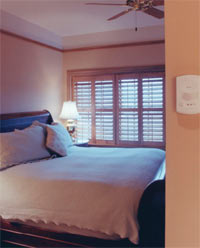Sensing a Silent Killer
Major revisions to NFPA 70 offer opportunities for security strategy changes
- By David George
- Nov 01, 2008
 Carbon monoxide detection has been around for some time, but has not been
mainstreamed—until now. When NFPA 720-2009, which is a complete rewrite
of the CO detection standard, was published, it addressed the trend of CO
detection with concise remedies to alleviate any uncertainties. The standard brought
about the opportunity to help facilities hone in on new protection strategies. According
to the National Fire Protection Association, CO detectors are only in about 15 percent
of homes in the United States. By comparison, 96 percent of homes have smoke
alarms. This new standard opens up the door to fill that gap.
Carbon monoxide detection has been around for some time, but has not been
mainstreamed—until now. When NFPA 720-2009, which is a complete rewrite
of the CO detection standard, was published, it addressed the trend of CO
detection with concise remedies to alleviate any uncertainties. The standard brought
about the opportunity to help facilities hone in on new protection strategies. According
to the National Fire Protection Association, CO detectors are only in about 15 percent
of homes in the United States. By comparison, 96 percent of homes have smoke
alarms. This new standard opens up the door to fill that gap.
Remember, CO is still a new thing—building professionals are often uncertain as
to where and how CO detection should be installed. Building owners, their design
teams and the responsible code-enforcement authorities all want direction for detector
locations that will protect occupants from accumulations of CO gas—exactly what
NFPA 720-2009 provides.
In fact, state and local governing entities have been amending their own adopted
codes with more centralized and more stringent CO detection requirements. While
many jurisdictions and cities, such as Chicago, have had additional CO detection
requirements for longer than a decade, the trend is accelerating in such places as New
York City and Florida. In addition, the recent changes to NFPA 720 validate the importance of CO detection and reinforce some of the building and life-safety codes that
have prescribed CO detection requirements addressing these uncertainties.
Here is a basic review of NFPA 720 and the strategies to consider:
NFPA 720 opens the playing field. The new code standardizes CO detection for all buildings, not just residences. This
includes schools, hotels, nursing homes
and other commercial structures. This is
the perfect opportunity to “cross sell”
your security protection strategies. In
addition, CO notification devices must
meet certain audible and visible requirements.
For example, public notification
appliances for CO signaling cannot
include the word “fire” or any fire symbol.
And while notification appliances
with multiple visible elements are permitted
to have fire markings only on those
visible elements used for fire signaling,
the new standard provides ample opportunities
for revisiting the security strategy
within a facility.
CO signals must be different. The
new code requires that the CO alarm signal
is distinct from other signals when
indicating sensor failure or end of life.
Keep in mind that the CO alarm signal
should take precedence over supervisory
or trouble signals, and should be distinctly
indicated as a CO alarm signal (visually
and audibly) at the control panel and
supervising station.
Additionally, the new code clarifies
what supervisory stations should do when
they receive a CO alarm signal. If the
communications methodology is shared
with any other usage, all fire alarm, CO
alarm, supervisory and trouble signals
will take priority, in that order of priority,
over all other signals unless otherwise
permitted by the AHJ.
CO meets smoke. According to the
new standard, CO detectors will now be
held to the same life-safety standard as
smoke detectors. This means they will
send trouble signals to the control panel
and facilitate wiring supervision.
For example, the code now spells out
where CO detectors should go. In commercial
buildings, CO detectors need to
be located on the ceiling in the same
room as permanently installed fuelburning
appliances and centrally located
on every habitable level and in every
HVAC zone of the building. In dwelling
units, CO detectors must be installed
outside each separate sleeping area and
on every level of a dwelling unit,
including basements.
Differences. One of the differences
between fire alarm systems and CO
detection systems is the secondary
power supply requirements. NFPA 720-
2009 requires CO detection systems to
have sufficient secondary power to
operate the system under quiescent load
for at least 24 hours. After that time, the
system must operate all of the CO notification
appliances for 12 hours if a
supervising station does not monitor the
system. If the CO detection system is
monitored by a supervising station, the
12-hour requirement is reduced to 60
minutes. Functional tests won’t take
effect until 2012, and sensitivity tests
won’t take effect until 2015. This gives
manufacturers enough time to implement
safe testing protocols.
Good news. Some manufacturers
already meet this testing requirement, providing
a simple, inexpensive test that verifies
the CO cell’s functionality when using
canned CO. With a one-second spray, the
user can ensure the
sensing cell is functioning
properly.